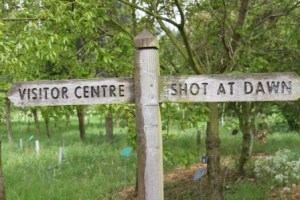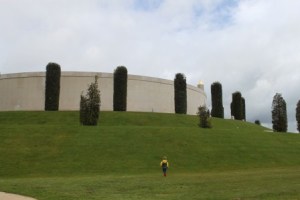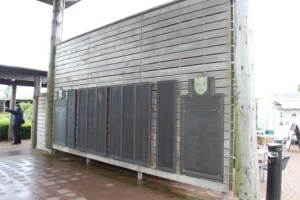Re-posted from Archaeodeath
Archaeologists have long debated the significance of monument reuse – the monumental ‘past in the past’ – as a way by which prehistoric and early historic people created their mythologies and histories. Despite some cynics and some misinterpretations, it is widely recognised that old things can provoke myth, legends and other forms of social memory through the materially engaged practices and somatic experiences of visiting, burying the dead, discovering old things, and reworking ancient monuments. Ruins and earthworks are not stores of indisputable tradition, instead they act as media by which connotations and narratives are wrapped around and become entangled through social practices and ritual performances.

Relocated from Basra, this memorial commemorates British military personnel killed in the war in Iraq, but also collectively cites a link between Britain’s and Iraq through its relocation from the war zone
In many cases this use of old monuments in memory work involves many strands of continuity linking monuments and memory over decades, centuries and sometimes millennia. This is a staged remembering and forgetting, both retrospective and prospective, through the persistent or created reuse of old monuments. In other instances, the tradition can be invented, absorbing, appropriating and replacing existing associations with a monument, representing a break with the past and the invention of tradition.
This discussion of the past in the past informs how we consider the past in the present too. At the National Memorial Arboretum, we find a brand new memorial landscape, developed around the Millennium as the UK’s national focus of memorialisation. Yet here, we find many attempts to integrate the past into contemporary and newly created commemorative environments. I have discussed the site and its many allusions to antiquity in previous blog posts here and here, relating to a publication in the International Journal of Heritage Studies, published online in Jan 2013 and in print form this month. The Armed Forces Memorial is a case in point.
In a brand new publication in the journal Archaeological Dialogues on the related but somewhat contrasting commemorative theme of ‘Monument and Material Reuse at the National Memorial Arboretum’. Here I explore the contrasting ways in which specific materials and monuments created for other locations have been translated and ‘saved’ for display within these new memorial gardens and woods.
I argue that this is not a universal trend and in some regards is in tension with allusions to deep antiquity within the NMA. Instead, I argue that the emotive tempo and specific mnemonic connections created by this reuse is particularly favoured for select categories of memorial: those linked to the suffering of civilian victims of war, memorials to peace, and memorials to military disasters and to the sufferings of prisoners of war. The NMA also operates as a museum for memorials that have lost their home elsewhere; they have become memorials to themselves: their display is commemorative of their subjects and also to the culture of commemoration itself.
As seen in the newly opened 9/11 Memorial Museum building on a longer tradition of using specific artefacts associated with atrocities found in Holocaust museums like Auchwitz-Birkenau, relics that trigger specific and direct tangible links from the present to specific localities and events, can provoke strong emotions and verifiable witnesses to specific narratives being constructed through memorialisation.
At the NMA we see a memorial context in which human loss and suffering is framed by sublimation into antiquity, yet for specific modes of memorialisation, the ‘real thing’ is deemed necessary.




